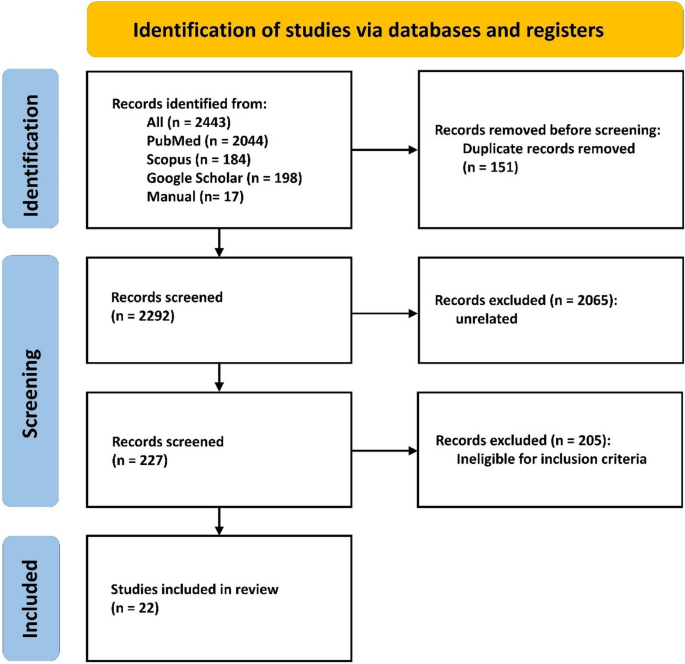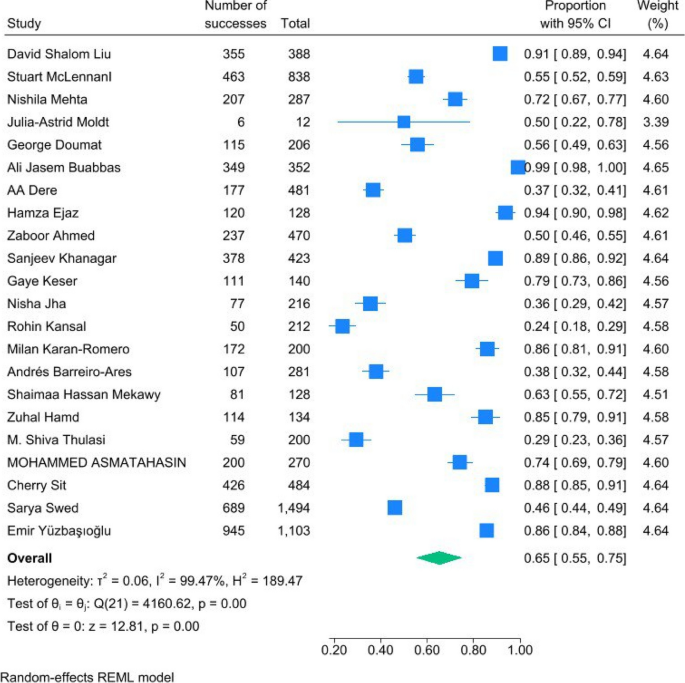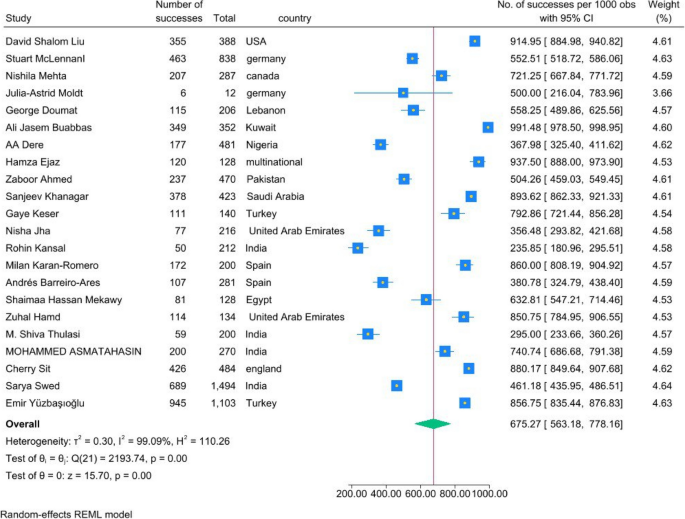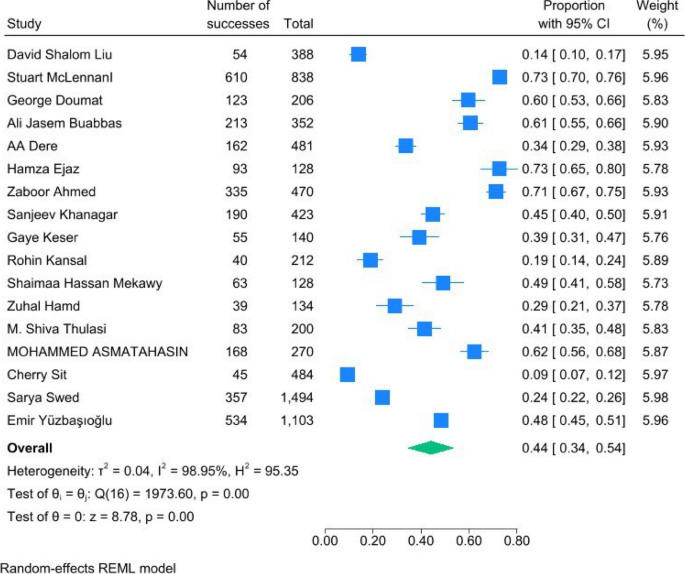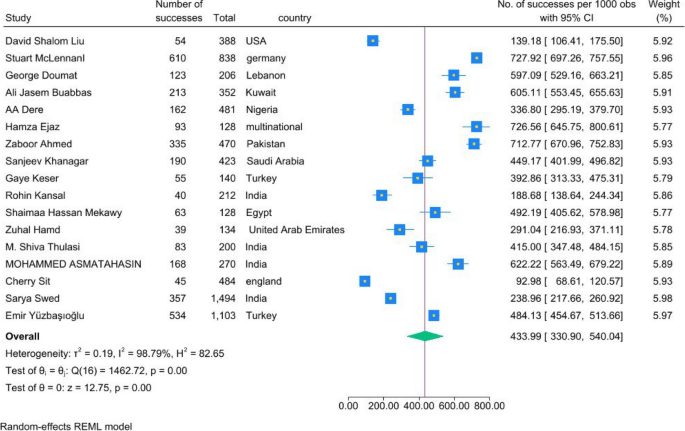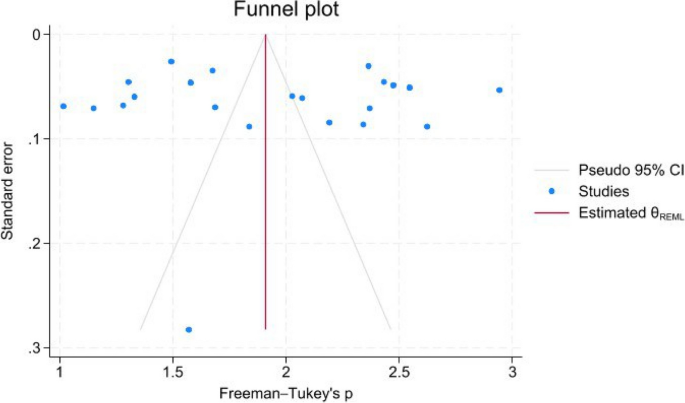- Research
- Open access
- Published:
Medical, dental, and nursing students’ attitudes and knowledge towards artificial intelligence: a systematic review and meta-analysis
BMC Medical Education volume 24, Article number: 412 (2024)
Abstract
Background
Nowadays, Artificial intelligence (AI) is one of the most popular topics that can be integrated into healthcare activities. Currently, AI is used in specialized fields such as radiology, pathology, and ophthalmology. Despite the advantages of AI, the fear of human labor being replaced by this technology makes some students reluctant to choose specific fields. This meta-analysis aims to investigate the knowledge and attitude of medical, dental, and nursing students and experts in this field about AI and its application.
Method
This study was designed based on PRISMA guidelines. PubMed, Scopus, and Google Scholar databases were searched with relevant keywords. After study selection according to inclusion criteria, data of knowledge and attitude were extracted for meta-analysis.
Result
Twenty-two studies included 8491 participants were included in this meta-analysis. The pooled analysis revealed a proportion of 0.44 (95%CI = [0.34, 0.54], P < 0.01, I2 = 98.95%) for knowledge. Moreover, the proportion of attitude was 0.65 (95%CI = [0.55, 0.75], P < 0.01, I2 = 99.47%). The studies did not show any publication bias with a symmetrical funnel plot.
Conclusion
Average levels of knowledge indicate the necessity of including relevant educational programs in the student’s academic curriculum. The positive attitude of students promises the acceptance of AI technology. However, dealing with ethics education in AI and the aspects of human-AI cooperation are discussed. Future longitudinal studies could follow students to provide more data to guide how AI can be incorporated into education.
Introduction
The term "artificial intelligence (AI)" was coined nearly 70 years ago to refer to using of computers to imitate human reasoning [1]. The first application of AI was in mathematics in 1956 when it was utilized for proving theorems [2]. Integrating of AI in medicine was a gradual process [3] that began with the development of a software program that guided doctors on appropriate antimicrobial therapy [4].
AI is a trending topic that is currently at the forefront of technological advancements [5] and has the potential to influence the healthcare industry significantly [6]. The term AI refers to a scientific and engineering discipline that deals with developing computer-based systems capable of exhibiting intelligent behavior, as well as understanding and replicating human-like cognitive processes [7]. Recent advancements in computer and informatics technologies have paved the way for integrating of AI technologies, such as machine learning and deep learning, into healthcare information systems [8, 9]. AI has been extensively integrated into decision support systems (DSSs) in data-intensive medical specialties like radiology, pathology, and ophthalmology [10].
Several experts have expressed their opinions on the future of radiology in light of AI's emergence [11, 12]. Radiological societies have also published white papers promoting their views [13, 14]. Studies have indicated that medical students do not express significant concern or fear about being replaced by AI in their profession [15]. However, some students may experience anxiety related to the possibility of being displaced by AI, which may discourage them from considering certain medical specialties [16]. Indeed, there are positive and negative perspectives on the impact of AI on daily human life. Pessimistic views suggest that AI may replace humans in various sectors. On the other hand, optimistic views highlight that individuals with AI support will have increased opportunities to leverage future advancements [17]. To the best of our knowledge, this study aimed to evaluate the attitudes, knowledge, and skills of medical, dental, and nursing students toward AI and to gather information about their opinions on the use of AI.
Method
This systematic review and meta-analysis study was based on the PRISMA (Preferred Reporting Items for Systematic Reviews and Meta-Analysis) guidelines. The protocol of this study was registered on PROSPERO with the ID of CRD42024521006.
Literature search
A structured literature search was applied up to 12th September 2023 to collect appropriate articles from PubMed /MEDLINE, Scopus, and Google Scholar databases. Search tactics included two main subgroups of keywords. One subgroup was the concepts related to artificial intelligence, and the other group was the perspective of health care and dentists; then, Subgroups were mixed by using ‘AND.’ More specifically, we searched the above databases for (artificial intelligence or machine learning) and (Medical or dentistry or nursing) (Table 1). The search process was done according to the query options of each database. In addition, we searched the reference lists of appropriate systematic reviews to prevent missing data. Two reviewers accomplished all strategies in a solitary state, and any controversy between the reviewers was resolved by negotiation.
Criteria for selecting studies
The main goal was to evaluate the attitudes of students and graduates working in dentistry, nursing, or medical (health care providers) fields toward AI and machine learning. We didn't use any restrictions on date and language, but to make the search more specific, we restricted the keyword search to the title. Articles with irrelevant subject matter and studies utilizing animal models were excluded during the initial phase of document selection. Additionally, duplicate documents were eliminated.
Data extraction and study quality assessment
Two reviewers independently assessed the title and abstract of each study to ascertain its suitability for inclusion in this meta-analysis. We excluded studies that didn’t fulfill our criteria. The complete text of the remaining studies was reviewed, and studies that met the criteria were included in the data extraction step. After that, the subsequent items were acquired for extraction and divided into four sets:
-
1. Study characteristics include authors, type of study, year, location, and follow-up duration.
-
2. Participant variables (average age, gender).
-
3. Research Methodology (e.g., participant sample size).
-
4. Results and outcomes (the attitude, knowledge, and skill toward artificial intelligence).
Two previously mentioned reviewers utilized the critical appraisal checklists for cohort, case–control, and analytical cross-sectional studies created by the Joanna Briggs Institute (JBI). The checklists can be found at the following website: https://jbi.global/critical-appraisal-tools. If there were any inconsistencies, a third author was involved in the process.
Statistical analysis
Our data analysis was conducted using the STATA 13.1 software developed by StataCorp LP in College Station, TX, USA. The findings were presented as combined odds ratios (ORs) and a 95% confidence interval displayed in a forest plot. Heterogeneity among the eligible studies was assessed using the I2 statistic. The random effects model was employed when significant heterogeneity was observed (I2 > 50%). In addition, we performed a sensitivity analysis by systematically excluding one study at a time and repeating the meta-analysis. This allowed us to guarantee the consistency of our conclusions. To assess the possibility of publication bias, we visually examined the symmetry of the funnel plot and conducted Egger’s regression analysis.
Result
Search strategy
We obtained 2426 from PubMed/MEDLINE, Scopus, and Google Scholar in the initial search. Seventeen studies were found by manual search. After the automatic removal of duplicated reports, 2292 studies remained. Two thousand sixty-five studies were excluded in the title and abstract evaluation. Two hundred twenty-seven remaining studies underwent additional assessment through full-text, causing 205 papers to be excluded due to ineligibility to inclusion criteria. Finally, 22 studies were included in this systematic review and meta-analysis (Fig. 1).
Baseline characteristic
This systematic review and meta-analysis evaluated the attitude, knowledge, and skills of medical, dental, and nursing students toward artificial intelligence. We included 22 original articles published from 2020–2023. These studies were performed in several countries, including the U.S.A [18], Germany [19, 20], Lebanon [21], Pakistan [22], Canada [23], The U.K. [24], United Arab Emirates [25], Nigeria [26], Turkey [27, 28], Spain [29] Saudi Arabia [30], India [31,32,33], Egypt [34], Peru [35], Nepal [36], Kuwait [37], Syria [38], and multiple countries [39]. The study design of 19 studies was cross-sectional [20,21,22,23,24,25,26,27,28,29,30,31,32,33,34,35,36,37,38], and the rest followed a mixed methodology [18, 19, 39]. This study included 8491 participants, with a mean age of 19–30 years (Table 2).
Attitude
We performed a meta-analysis on 22 studies for attitude of students toward AI. The proportion for attitude was 0.65 (95%CI = [0.55, 0.75], P < 0.01) according to 22 studies. This means that 65% of all students were agree with the use of AI in medicine and had a favorable view. Similarly, the heterogeneity was severe with I2 of 99.47%, and H2 = 189.47 (Fig. 2).
In comparison between various countries, students in the U.S.A. Kuwait, Saudi Arabia, Turkey, and England showed a higher rate of attitude toward AI than those in Germany, Lebanon, Nigeria, Pakistan, and India. Additionally, the Attitudes of Spanish and United Arab Emirates students varied in different studies. Finally, students in Canada and Egypt displayed a medium rate of positive attitude (Fig. 3).
Knowledge
A total of 17 studies had provided the knowledge data. The pooled analysis showed a proportion for knowledge of 0.44 (95%CI = [0.34, 0.54], P < 0.01). This shows that 44% of the total population of included students had a relatively good knowledge about AI, either in the field of theory or practical. The studies showed a high heterogeneity with an I2 of 98.95% and H2 of 93.35 (Fig. 4).
Students from Germany, Lebanon, Kuwait, and Pakistan had higher levels of knowledge in the field of AI. In contrast, students from the U.S.A., Nigeria, the United Arab Emirates, and England showed a relatively lower knowledge level. Additionally, the level of knowledge in Indian students varied across different studies. Finally, students from Egypt, Saudi Arabia, and Turkey showed moderate knowledge (Fig. 5).
Publication bias
The publication bias was evaluated through the funnel plot and Egger’s test. The funnel plot (Fig. 6) showed a symmetrical pattern, indicating no publication bias. This was supported by Egger’s test result (P = 0.75).
Discussion
This systematic review and meta-analysis aimed to provide evidence on medical, dental, and nursing students’ attitudes, knowledge, and skills regarding AI. Across 24 studies with 5789 participants, students demonstrated moderate knowledge but generally positive attitudes towards AI.
Overall, 44% of students exhibited medium to high knowledge of AI principles and applications. Knowledge encompassed theoretical understanding of AI algorithms, practical abilities to implement AI systems, and programming proficiency. However, the majority of students had limited AI knowledge. This knowledge gap signals an urgent need to incorporate comprehensive AI education into healthcare curricula. Studies show that students support this idea [40, 41]. Curricula should cover foundational concepts like machine learning and neural networks as well as applied skills in utilizing AI tools for tasks like diagnostic imaging interpretation. Hands-on experiential learning with real-world case examples could prove highly effective. Other reason is that lack of knowledge is an important barrier to the use of AI [42]. Notably, students from developed countries demonstrated greater AI knowledge than peers in developing nations. This has been shown in previous studies as well [43]. This discrepancy highlights concerning global digital divides in accessing AI skills training. Targeted investments and capacity building programs are critical to ensuring students worldwide can gain applied AI competencies.
In contrast to their variable knowledge, 65% of students expressed positive attitudes regarding AI utilization in education and clinical practice. This was also showed in previous studies that most of healthcare students have a positive attitude towards AI [19, 44,45,46,47]. Students recognized potential benefits of AI for enhancing diagnostic accuracy, improving healthcare access, and relieving clinical workloads. In contrast there are negative perceptions too [44, 48, 49].
Attitudinal measures had substantial heterogeneity, reflecting divergent perceptions across student subgroups. In particular, developing world students held more skeptical views, fearing AI could dehumanize care or render healthcare jobs obsolete. Curricula must address these valid ethical and social concerns through discussions of AI bias, transparency, and impacts on healthcare roles. It should be noted that patient privacy and autonomy, informed consent, transparency, equality and biases are some of major concerns [50]. Refining attitudinal measures with more granular subsets and exploring predictors of AI acceptance would further inform targeted educational initiatives based on students’ specific concerns.
Enthusiasm and optimism vs. expertise gaps
Overall students showed enthusiasm and optimism about AI's role in medicine, yet the majority lacked substantial expertise and practical abilities in utilizing AI technology. A similar pattern exists in other majors too. A study by Busch et al. involving 387 pharmacy students from 12 countries found that 58% of students held positive attitudes towards AI in medicine, while 63% reported limited general knowledge of AI [51]. Bridging these attitude-knowledge gaps represents a key challenge for AI readiness. Curricula must not only transfer technical knowledge but also address values, ethics, and societal impacts. Education should emphasize AI as a collaborative tool to augment human capabilities rather than replace them. Again, having students directly experience AI’s benefits for care quality could show its potential for enhancing work rather than displacing workers. Additionally, equitable access to AI upskilling is imperative, particularly for students from disadvantaged regions who may have heightened concerns about AI’s risks.
Strength and limitations
The strength of our study is the review of articles from three large databases, including PubMed, Scopus, and Google Scholar. Also, we used the random effect model to ensure the robustness of the results. Also, our study had some limitations. We included only studies in English. In addition, most of the included studies used their own questionnaires to evaluate the knowledge and approach of the participants toward artificial intelligence. Finally, it is necessary to mention that there were not enough studies to extract the skill results and perform a meta-analysis.
Future research directions
Future research should investigate the long-term knowledge and attitudinal trajectories of students after graduation. As AI becomes further embedded into real-world practice, how do provider perspectives evolve? Do knowledge gaps persist or does on-the-job exposure improve understanding? How do early attitudinal concerns translate to technology adoption patterns? Longitudinal data tracking cohorts of students into practice could provide pivotal insights to guide continuing education and change management interventions.
Follow-up studies should also assess the durability of AI skills training. Can one-time education produce lasting competencies or is ongoing reinforcement needed? Comparisons of different pedagogical approaches for AI instruction could illuminate best practices as well. And crucially, future work must evaluate links from AI education to concrete improvements in clinical processes and patient outcomes. Demonstrating benefits to care quality represents the strongest incentive for curriculum reform.
Conclusion
AI is rapidly transforming healthcare and medical education. However, the extent to which healthcare students are prepared for this transformation remains unclear. The moderate knowledge levels indicate substantial room for improvement through curricular enhancement. Hands-on experiential learning focused on applied AI skills shows promise for durably improving competencies. Positive baseline attitudes bode well for acceptance, but targeted education around AI ethics, impacts, and human-AI collaboration will be key to realizing this potential.
Important gaps remain in understanding long-term knowledge retention, optimal pedagogies, impacts of improved education on clinical processes and outcomes, and equitable global access. Follow-up longitudinal studies tracking cohorts of students into practice could offer pivotal data to guide continuing education. Comparisons of instructional approaches may illuminate best practices.
Availability of data and materials
The datasets generated and analyzed during the current study are not publicly available but are available from the corresponding author on reasonable request.
Abbreviations
- AI:
-
Artificial intelligence
References
Larentzakis A, Lygeros N. Artificial intelligence (AI) in medicine as a strategic valuable tool. Pan Afr Med J. 2021;38:184.
Russell S, Norvig P. Artificial Intelligence, A Modern Approach. Second Edition. 2003. p 1081.
Kaul V, Enslin S, Gross SA. History of artificial intelligence in medicine. Gastrointest Endosc. 2020;92(4):807–12.
Shortliffe EH, et al. Computer-based consultations in clinical therapeutics: Explanation and rule acquisition capabilities of the MYCIN system. Comput Biomed Res. 1975;8(4):303–20.
Morris K, Schlenoff C, Srinivasan V. A Remarkable Resurgence of Artificial Intelligence and Its Impact on Automation and Autonomy. IEEE Trans Autom Sci Eng. 2017;14:407–9.
Hinton G. Deep Learning-A Technology With the Potential to Transform Health Care. JAMA. 2018;320(11):1101–2.
Shapiro, S.C., Artificial intelligence (AI), in Encyclopedia of Computer Science. 2003, John Wiley and Sons Ltd. p. 89–93.
Miotto R, et al. Deep learning for healthcare: review, opportunities and challenges. Brief Bioinform. 2018;19(6):1236–46.
Xiao C, Choi E, Sun J. Opportunities and challenges in developing deep learning models using electronic health records data: a systematic review. J Am Med Inform Assoc. 2018;25(10):1419–28.
Yu KH, Kohane IS. Framing the challenges of artificial intelligence in medicine. BMJ Qual Saf. 2019;28(3):238–41.
Moehrle A. “Radiology” Is Going Away . . . and That’s Okay: Titles Change, A Profession Evolves. J Am Coll Radiol. 2018;15(3):499–500.
Schier R. Artificial Intelligence and the Practice of Radiology: An Alternative View. J Am Coll Radiol. 2018;15(7):1004–7.
Beregi JP, et al. Radiology and artificial intelligence: An opportunity for our specialty. Diagn Interv Imaging. 2018;99(11):677–8.
Tang A, et al. Canadian Association of Radiologists White Paper on Artificial Intelligence in Radiology. Can Assoc Radiol J. 2018;69(2):120–35.
Pinto Dos Santos D, et al. Medical students’ attitude towards artificial intelligence: a multicentre survey. Eur Radiol. 2019;29(4):1640–6.
Gong B, et al. Influence of Artificial Intelligence on Canadian Medical Students’ Preference for Radiology Specialty: ANational Survey Study. Acad Radiol. 2019;26(4):566–77.
Johnston SC. Anticipating and Training the Physician of the Future: The Importance of Caring in an Age of Artificial Intelligence. Acad Med. 2018;93(8):1105–6.
Liu DS, et al. Perceptions of US medical students on artificial intelligence in medicine: mixed methods survey study. JMIR Medical Education. 2022;8(4): e38325.
Moldt J-A, et al. Chatbots for future docs: exploring medical students’ attitudes and knowledge towards artificial intelligence and medical chatbots. Med Educ Online. 2023;28(1):2182659.
McLennan S, et al. German medical students´ views regarding artificial intelligence in medicine: A cross-sectional survey. PLOS Digital Health. 2022;1(10): e0000114.
Doumat G, et al. Knowledge and attitudes of medical students in Lebanon toward artificial intelligence: A national survey study. Frontiers in artificial intelligence. 2022;5:1015418.
Ahmed Z, et al. Knowledge, attitude, and practice of artificial intelligence among doctors and medical students in Pakistan: A cross-sectional online survey. Annals of Medicine and Surgery. 2022;76: 103493.
Mehta N, et al. Knowledge and Attitudes on Artificial Intelligence in Healthcare: A Provincial Survey Study of Medical Students. MedEdPublish. 2021;10:75.
Sit C, et al. Attitudes and perceptions of UK medical students towards artificial intelligence and radiology: a multicentre survey. Insights Imaging. 2020;11:1–6.
Hamd Z, et al. A closer look at the current knowledge and prospects of artificial intelligence integration in dentistry practice: A cross-sectional study. Heliyon. 2023;9(6):e17089.
Dere, A.A., Knowledge and Attitude of Medical Students and Doctors towards Artificial Intelligence: A study of University of Ilorin. 2023.
Yüzbaşıoğlu E. Attitudes and perceptions of dental students towards artificial intelligence. J Dent Educ. 2021;85(1):60–8.
Keser G, PEKİNER F.M.N. Attitudes, perceptions and knowledge regarding the future of artificial intelligence in oral radiology among a group of dental students in Turkey: a survey. Clinical and Experimental Health Sciences. 2021;11(4):637–41.
Barreiro-Ares A, et al. Impact of the rise of artificial intelligence in radiology: what do students think? Int J Environ Res Public Health. 2023;20(2):1589.
Khanagar S, et al. Knowledge, attitudes, and perceptions of dental students towards artificial intelligence in Riyadh. Saudi Arabia Med Sci. 2021;25(114):1857–67.
Kansal R, et al. Differences in knowledge and perspectives on the usage of artificial intelligence among doctors and medical students of a developing country: a cross-sectional study. Cureus. 2022;14(1):e21434.
Asmatahasin M, et al. Attitude and perception of dental students towards artificial intelligence. Indian Journal of Basic and Applied Medical Research. 2021;10(3):305–14.
Thulasi MS, et al. Knowledge attitude and practices of dental students and dental practitioners towards artificial intelligence. International Journal of Intelligent Systems and Applications in Engineering. 2022;10(1s):248–53.
Hassan Mekawy S, Ali Mohamed Ismail S, Zayed Mohamed M. Digital Health Literacy (DHL) Levels Among Nursing Baccalaureate Students And Their Perception And Attitudes Toward The Application Of Artificial Intelligence (AI) In Nursing. Egyptian Journal of Health Care. 2020;11(1):1266–77.
Karan-Romero M, Salazar-Gamarra RE, Leon-Rios XA. Evaluation of Attitudes and Perceptions in Students about the Use of Artificial Intelligence in Dentistry. Dentistry Journal. 2023;11(5):125.
Jha N, et al. Undergraduate medical Students’ and Interns’ knowledge and perception of artificial intelligence in medicine. Adv Med Educ Pract. 2022;(13):927–37.
Buabbas, A.J., et al. Investigating Students’ Perceptions towards Artificial Intelligence in Medical Education. in Healthcare. 2023. MDPI.
Swed S, et al. Knowledge, attitude, and practice of artificial intelligence among doctors and medical students in Syria: a cross-sectional online survey. Frontiers in artificial intelligence. 2022;5:1011524.
Ejaz H, et al. Artificial intelligence and medical education: A global mixed-methods study of medical students’ perspectives. Digital Health. 2022;8:20552076221089100.
Banerjee M, et al. The impact of artificial intelligence on clinical education: perceptions of postgraduate trainee doctors in London (UK) and recommendations for trainers. BMC Med Educ. 2021;21(1):429.
Pupic N, et al. An evidence-based approach to artificial intelligence education for medical students: A systematic review. PLOS Digit Health. 2023;2(11): e0000255.
Singh N, et al. Attitude, perception and barriers of dental professionals towards artificial intelligence. J Oral Biol Craniofac Res. 2023;13(5):584–8.
Mousavi Baigi SF, et al. Attitudes, knowledge, and skills towards artificial intelligence among healthcare students: A systematic review. Health Sci Rep. 2023;6(3): e1138.
AlZaabi A, AlMaskari S, AalAbdulsalam A. Are physicians and medical students ready for artificial intelligence applications in healthcare? DIGITAL HEALTH. 2023;9:20552076231152170.
Chen, M., et al., Acceptance of clinical artificial intelligence among physicians and medical students: A systematic review with cross-sectional survey. Frontiers in Medicine, 2022. 9.
Gillissen A, Kochanek T, Zupanic M, Ehlers E. "Medical students’ perceptions towards digitization and artificial intelligence: a mixed-methods study." Healthcare. 2022;10(4):723.
Karan-Romero M, Salazar-Gamarra RE,Leon-Rios XA. Evaluation of attitudes and perceptions in students about the use of artificial intelligence in dentistry. Dent J. 2023;11(5):125.
Sheela J. Attitude of Nursing Students towards Artificial Intelligence. Int J Sci Healthc Res. 2022;7(2):344-347.
Jussupow E, Spohrer K, Heinzl A. Identity Threats as a Reason for Resistance to Artificial Intelligence: Survey Study With Medical Students and Professionals. JMIR Form Res. 2022;6(3): e28750.
Prakash S, et al. Ethical Conundrums in the Application of Artificial Intelligence (AI) in Healthcare-A Scoping Review of Reviews. J Pers Med. 2022;12(11):1914.
Busch F, et al. International pharmacy students' perceptions towards artificial intelligence in medicine-A multinational, multicentre cross-sectional study. Br J Clin Pharmacol. 2023;90(3):649–61.
Liu DS, et al. Perceptions of US Medical Students on Artificial Intelligence in Medicine: Mixed Methods Survey Study. JMIR Med Educ. 2022;8(4): e38325.
McLennan S, et al. German medical students´ views regarding artificial intelligence in medicine: A cross-sectional survey. PLOS Digit Health. 2022;1(10): e0000114.
Acknowledgements
We appreciate all the authors of included studies.
Funding
None.
Author information
Authors and Affiliations
Contributions
Study design and conception: M.AA; Search & study selection: H.A, S.P; Data extraction: SS.RS, M.P; Quality assessment: MN.N, MH.E; Statistical analysis and interpretation: M.S, F.M; Drafting the manuscript: H.A, S.P, SS.RS, M.P, MN.N, MH.E, M.S, F.M, MH.A; Critical revision: M.AA. All authors were approved the submitted version.
Corresponding author
Ethics declarations
Ethics approval and consent to participate
Not applicable.
Consent for publication
Not applicable.
Competing interests
The authors declare no competing interests.
Additional information
Publisher’s Note
Springer Nature remains neutral with regard to jurisdictional claims in published maps and institutional affiliations.
Supplementary Information
Rights and permissions
Open Access This article is licensed under a Creative Commons Attribution 4.0 International License, which permits use, sharing, adaptation, distribution and reproduction in any medium or format, as long as you give appropriate credit to the original author(s) and the source, provide a link to the Creative Commons licence, and indicate if changes were made. The images or other third party material in this article are included in the article's Creative Commons licence, unless indicated otherwise in a credit line to the material. If material is not included in the article's Creative Commons licence and your intended use is not permitted by statutory regulation or exceeds the permitted use, you will need to obtain permission directly from the copyright holder. To view a copy of this licence, visit http://creativecommons.org/licenses/by/4.0/. The Creative Commons Public Domain Dedication waiver (http://creativecommons.org/publicdomain/zero/1.0/) applies to the data made available in this article, unless otherwise stated in a credit line to the data.
About this article
Cite this article
Amiri, H., Peiravi, S., rezazadeh shojaee, S. et al. Medical, dental, and nursing students’ attitudes and knowledge towards artificial intelligence: a systematic review and meta-analysis. BMC Med Educ 24, 412 (2024). https://doi.org/10.1186/s12909-024-05406-1
Received:
Accepted:
Published:
DOI: https://doi.org/10.1186/s12909-024-05406-1
